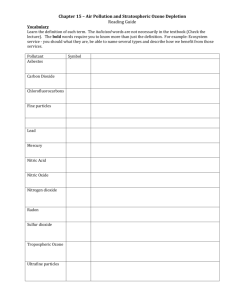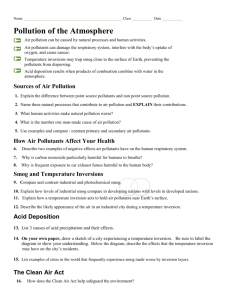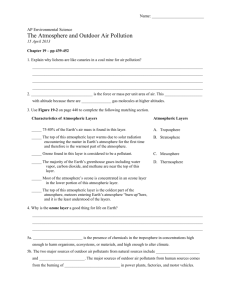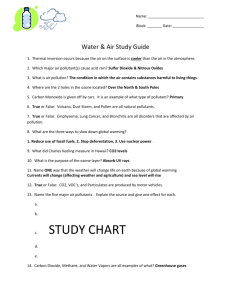AP Chapter 15 - Madeira City Schools
advertisement
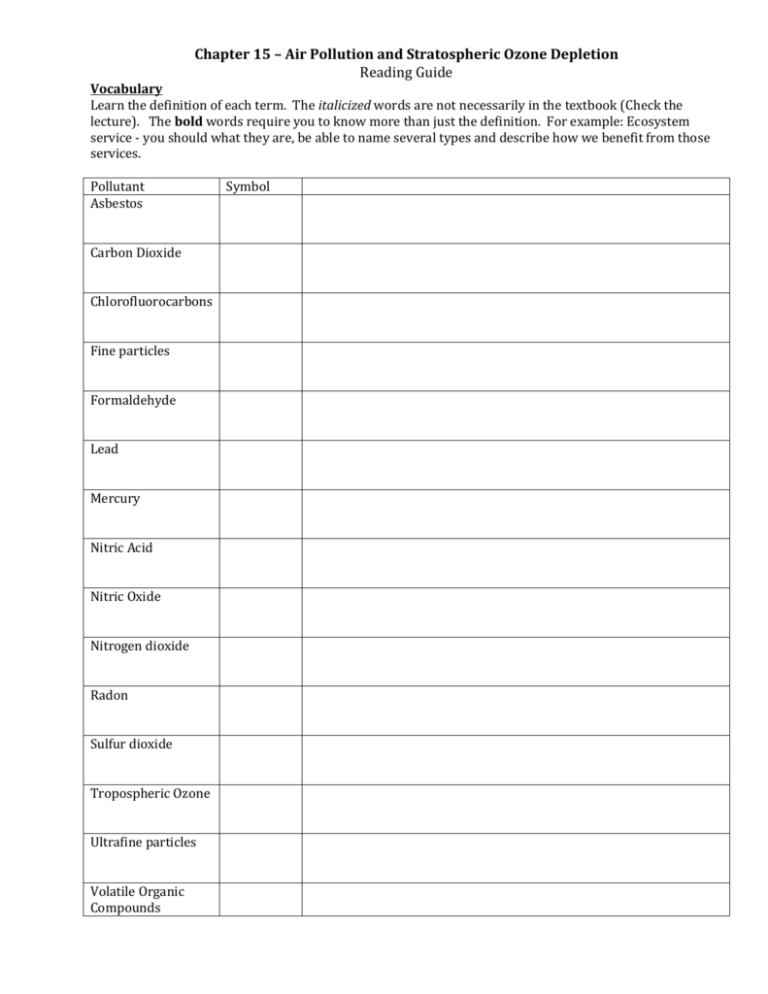
Chapter 15 – Air Pollution and Stratospheric Ozone Depletion Reading Guide Vocabulary Learn the definition of each term. The italicized words are not necessarily in the textbook (Check the lecture). The bold words require you to know more than just the definition. For example: Ecosystem service - you should what they are, be able to name several types and describe how we benefit from those services. Pollutant Asbestos Carbon Dioxide Chlorofluorocarbons Fine particles Formaldehyde Lead Mercury Nitric Acid Nitric Oxide Nitrogen dioxide Radon Sulfur dioxide Tropospheric Ozone Ultrafine particles Volatile Organic Compounds Symbol Primary air pollutant Secondary air pollutant NAAQS Clean Air Act Thermal inversion Acid deposition Fluidized bed combustion Catalytic converter Smokestack scrubber Electrostatic precipitator Pollution permits Ozone layer hole Sick building syndrome Stratospheric Ozone Montreal Protocol Cleaning Up in Chattanooga 1. How did Chattanooga’s geography contribute to its air pollution problem? 2. List the things Chattanooga did to clean up air pollution. 3. Why did Chattanooga continue to have an ozone problem even after cleaning up other types of air pollution? 15.1 Air pollutants are found throughout the entire global system 4. Name a few natural and a few anthropogenic sources of air pollution. 5. Why is air pollution a global problem? Support your answer with examples. 6. List the 6 criteria air pollutants and their chemical formulas. What law allows the EPA to regulate these pollutants? 7. What pollutants have been added to the list of pollutants covered by the Clean Air Act? Which ones probably should be added? 8. You should memorize the Table 15.1: Major Air Pollutants. You should also know any NATURAL SOURCES of each air pollutant. i.e. volcanoes produce PM, SO2, CO2, CO, etc. Covered in next section. 9. What is the difference between photochemical/brown smog, sulfurous/gray smog and atmospheric brown cloud? 15.2 Air pollution comes from both natural and human sources 10. List the air pollutants created by the following natural sources of air pollution: a. Volcanoes b. Lightning c. Forest Fires d. Plants – 11. Fill in the chart below using Figure 15.5. Pollutant Top 3 Sources Is source natural or anthropogenic? Carbon monoxide Nitrogen oxides Sulfur dioxide PM2.5 15.3 Photochemical smog is still an environmental problem in the US 12. What two air pollutants are major contributors to smog formation? 13. How does temperature influence smog formation? Why? 14. How does an inversion layer influence smog formation? Why? 15.3 Acid deposition is much less of a problem than it used to be 15. How has the US reduced acid deposition? 16. Is acid deposition a local, regional or global problem? Explain. 17. List the environmental, economic and human health impacts associated with acid rain. 15.4 Pollution control includes prevention, technology, and innovation 18. List some ways to PREVENT air pollution. 19. How can we control sulfur dioxide emissions? Include any drawbacks to the control methods. 20. How can we control nitrogen oxide emissions? Include any drawbacks to the control methods. 21. How can we control particulate matter emissions? Include any drawbacks to the control methods. 22. How does a baghouse/fabric filter work? What does it remove? 23. How does an electrostatic precipitator work? What does it remove? 24. How does a scrubber work? What does it remove? 25. List 5 or 6 other ways to reduce pollution. 15.5 The stratospheric ozone layer provides protection from UV solar radiation 26. Ozone is often described as “good uphigh, but bad nearby”. Explain why. 27. What are the benefits of stratospheric ozone? 28. What chemicals cause ozone loss? 29. Where and when (months and season) does the ozone hole form? 30. What is the Montreal Protocol? Has it been effective? 15.5 Indoor air pollution is a significant hazard, particularly in developing countries 31. Why is indoor air pollution a bigger problem in developing countries? 32. Why is indoor air pollution a problem in developed countries? 33. Fill out the chart below for indoor air pollutants Pollutant Formula Description Asbestos Sources Impacts N/A Carbon Monoxide Radon Volatile Organic Compounds 1Working towards sustainability: A New Cook Stove Design 34. How do households in China, India and sub-Saharan Africa typically cook food? What problems do this cause? 35. Describe some of the options for better cook stoves. Include any trade-offs.


